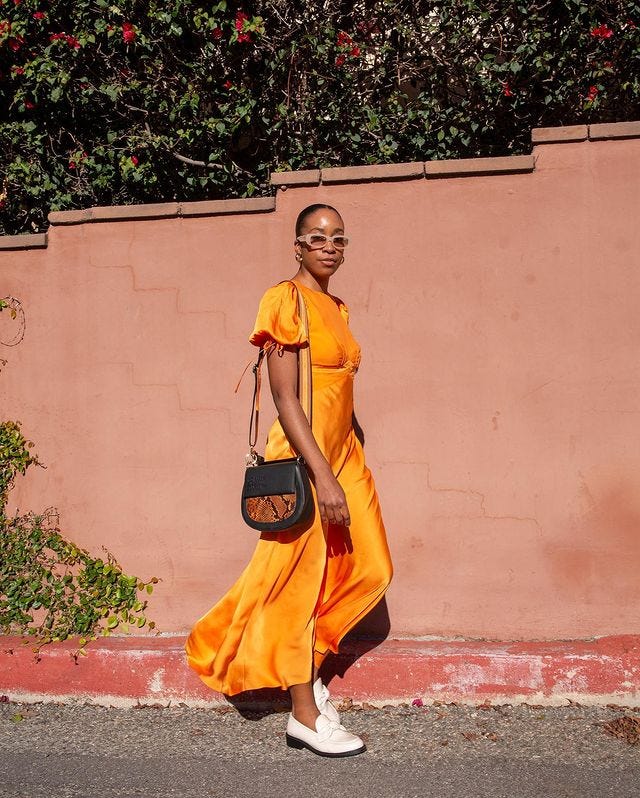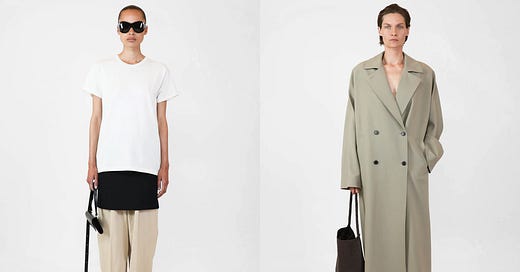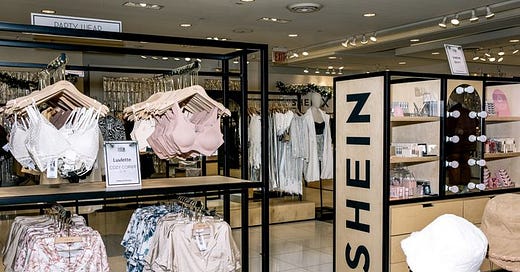

Discover more from Back Row
Let There Be Spon Con
Editors are leaving media jobs they enjoy to be influencers, even though some say they would be happy doing both. Why can't they?
Some of you have kindly asked me why I don’t paywall this thing and how you can support me. While I make this newsletter available entirely for free, the best thing you can do to support me as a writer and therefore this publication is pre-order my book, ANNA: The Biography, being released May 3. It is one of Apple Books’s most anticipated books of 2022, and an ideal beach read. (Pairs well with rosé and White Claw.) If you are new to Back Row, please subscribe to get more posts like this sent to your inbox two-ish times a week.
I suppose there are things that would bring one’s forehead into voluntary forceful contact with a wall other than the modern media industry. But you read enough about Joe Rogan elsewhere, so media in 2022 it is!
Last week, tears were shed over the closure of InStyle, Entertainment Weekly, and four other print editions following Meredith’s merger with DotDash. These closures resulted in the loss of about 200 jobs, the Wall Street Journal reported. It’s a reminder that very few people — if anyone (Anna Wintour and only Anna Wintour?) — are safe in this business. This makes media company policies that financially and professionally hinder their employees truly frustrating to talent who otherwise mostly enjoy their jobs and don’t want to leave them.
One of the best ways for many magazine employees to freelance these days is by selling content on their personal social media feeds. This often arises because a brand has approached them directly. A skincare brand might pay an influencer to make a video using a product, a clothing brand might ask for a series of photos of an influencer wearing their stuff, a liquor brand might ask an influencer to host a gathering with drinks and photograph it for social media. While these deals are more likely to go to people will tens of thousands of followers, sometimes editors with ten thousand or fewer are approached for deals. This practice became increasingly widespread over the past dozen years or so, as Instagram became fashion’s front page, and the general public’s media diets shifted from following publications to following individual people.
The policies at various major media companies concerning how editors are supposed to handle these deals vary, but after some asking around, I’ve learned that Hearst tells employees it’s not allowed (some do it anyway), Vogue takes a 40 percent cut, and Bustle parent company BDG and Who What Wear allow it. At Meredith, things are likely to be up in the air right now given the merger, but I was told by a former employee there was never a clear policy.*
I reached out to all of these companies for comment, and Bustle was the only one who sent me one. "Many of our editors have built an influential social presence and following for themselves, and it is natural that brands would like to engage with them on promotional work. With guidelines in place, we fully support those external partnerships that align with their personal brands,” a company spokesperson said in an email.
[NOTE: If you have information on a specific company that you would like to share, write me by replying to this email or DM me on Instagram @instamyodell and I will update this post with your intel. I figure it’s valuable to share this information so people can negotiate.]
In 2020, the year Chrissy Rutherford left Hearst-owned Harper’s Bazaar to become a full-time influencer, she tripled her salary. “I loved that job, I really did. It was my dream job and I gave it everything I had and it was sad to leave,” she said. But having to turn down so many branded deals was no longer making financial sense. Toward the end of her time at Bazaar, she was charging around $2,500 to $4,000 per sponsorship of her personal feed, which had tens of thousands of followers (now she has 165,000). Meanwhile, Hearst was paying editors a flat rate (of $500, Rutherford recalled, later increased to $1,000 in 2019, Business of Fashion reported) for participating in branded deals sold by the company, even if the total ad buy was a six-figure deal. “I think if things felt a little bit more fair, maybe I would have stuck it out,” Rutherford said.
Another editor at a top digital publisher told me she left her job in the late 2010s for the same reason. Unlike Rutherford, after a number of hourlong conversations about it, she was allowed to take branded deals on the side so long as her company got a 40 to 50 percent cut from each deal. The company’s reasoning, as she remembered it, was that her social clout had come in large part from being employed there. However, while taking at least double a typical agent’s fee of 15 to 20 percent, the company wasn’t actively working to get her sponsorships — she was bringing them in on her own. Friends at competing publishers told her she was lucky she had figured out an arrangement at all. But she kept a spreadsheet of all her deals and realized that if she wasn’t giving half of her earnings to her employer, she would make a living from influencing. She left, grew her business, and has never looked back. “I don’t think there was any mal-intent on their end. I think we were both figuring out a situation where there was no rule book,” she said.
Media companies tend to provide murky explanations for prohibitive policies surrounding editor spon con. However, based on conversations with numerous current and former fashion media company employees, it seems that some common points made to editors include: 1. You got your social following by being employed at This Important Media Brand, 2. This is a conflict of interest because we sell ads to these brands too, and 3. We just can’t pivot our sales teams to function as an influencer agency.
For decades, freelance writing outside of a staff magazine job has been accepted. Certain rules applied, either tacitly or explicitly. A staffer at a magazine generally knew not to freelance for a direct competitor or sell an article that their employer would publish. But an employee of Vogue, for example, could probably write a profile for Forbes about a Pepsi executive without anyone getting upset. Say the piece paid $2 a word and ran at 1,800 words — that’s an extra $3,600.
Today, increasingly few well-paid freelance writing assignments exist. Many online articles pay flat fees of around $200. So the best way for many fashion media employees to earn money through freelance work is by selling sponsorships of their personal social media feeds. The idea of editors doing this has left many media executives aghast and unsure of how to handle it. Selling their creative work in the form of articles was one thing, but selling it in the form of images and videos specifically to advertisers has left them spooked.
As someone who used to work at media companies, I understand the frustrations of publishers. I can understand why, in the 2010s, when all this was just beginning, it would have seemed terrifying and deeply threatening. Especially since magazine media has been hurting since the Great Recession of 2008. Revenue of periodical publishers was $46 billion in 2007, and steadily declined to $23.9 billion in 2021. In 2022, a greater share of global advertising dollars will go toward social media than any other medium, according to a projection by media agency Zenith. (The next biggest buckets are television and paid search.)
Now, I wonder if partly what was so scary to magazine publishers about employee spon con was that these individuals on the editorial side were selling ads without the things we have long understood needed to happen to do that, like employing large sales teams who orchestrate elaborate pitches for advertisers. That marketers were finding a new way to spend money represented something huge and uncomfortable for people who have been doing things a certain way for decades.
However, looking at editor spon con as competitive with a traditional publisher is, in this decade, a mistake. Sponsoring an individual’s feed is completely different from advertising in a publication. Companies engaging in influencer marketing set aside money specifically for this, and separate money specifically for advertising in publications. These should not be viewed as competing practices, but rather, more like a Vogue editor doing a freelance story for Forbes.
Plus, editors in the 2020s aren’t making the salaries that people made in these jobs in the nineties and aughts. Nor are they getting the raises they got in past decades. Nor is rising in the ranks to better paying, more senior roles practically guaranteed, as it once was. Having a senior level editorial role is, for many people, no longer possible because they often don’t exist and, when they do, they don’t pay enough for people who live in cities with high costs of living and want to do completely normal life things, like have kids and save to buy homes.
Augmenting one’s media salary is often not just nice, but a necessity. Today, media companies should allow spon con if for no other reason than to retain creative talent. Many people leaving to become influencers enjoy their magazine jobs and would like to do both.
One editor-turned-influencer noted that, should a media company take things a step further and try to sell deals for individual editors, not everyone will be able to get brand deals anyway, so the business side wouldn’t suddenly have to try to sell deals for hundreds of editorial employees. But even if they decided they had to pivot in order to cut themselves into these deals, so what? As Google and Facebook efficiently siphoned ad money from traditional publishers over the last decade or so, editorial teams have done nothing but pivot — from print to digital, from direct traffic to social traffic, from social traffic to SEO traffic, from a website-forward approach to a social media-forward one, and, perhaps most infamously of all, from text to video. Platforms editors have to keep up with include: websites, YouTube, Instagram, Facebook, Google, Twitter, TikTok, and — if they still exist — print magazines.
The industry is in its current heartbreaking position in large part because of a disconnect between creatives and executives. That there is no umbrella policy on the issue of sponsored content — the way people generally have understood not to freelance write for competitors — points to the dysfunction in media generally.
Editorial employees have been jumping through hoops to satisfy quickly changing business imperatives for many years now. Executives and ad sales teams could, by encouraging these sponsorships on the side, reward that effort. It would also show that they are willing to do the same things they’ve long expected of the creative side of the business.
Subscribe to Back Row to get posts like this sent straight to your inbox and support independent fashion journalism.
Update, February 18, 2022:
Here are some additional spon con policies:
Bloomberg forbids spon con, in keeping with its policy that journalists remain completely distinct from advertisers and brands. Unlike at fashion magazines, gifts and press trips are also forbidden.
BDG allows spon con with approval, though a source told me that it’s unclear what allows some deals to fly but not others.
At Are Media in Australia, editor spon con is allowed so long as the company gets the full fee.













Another amazing read. Keep up the great work!